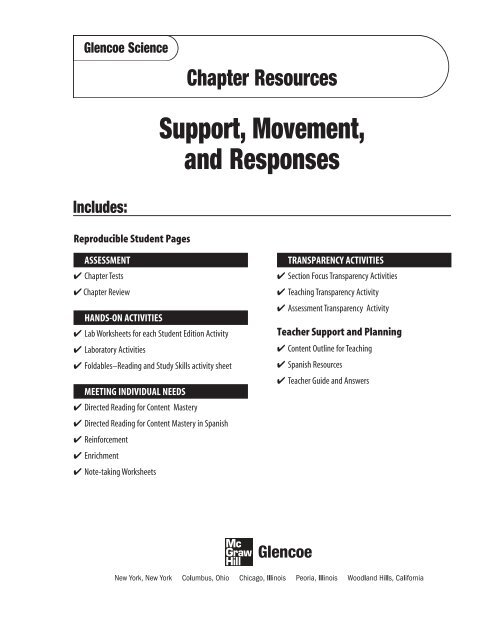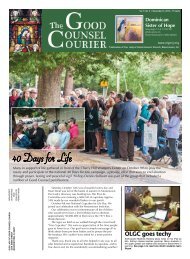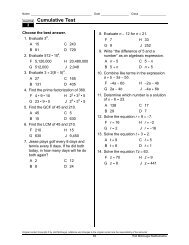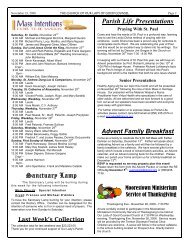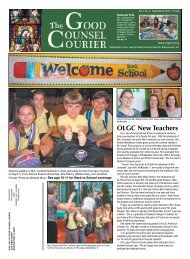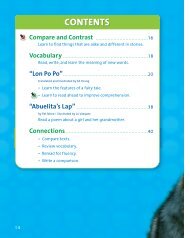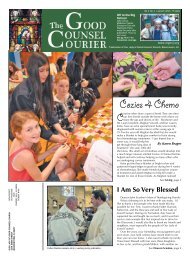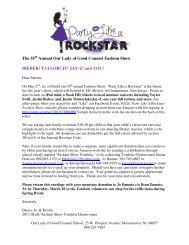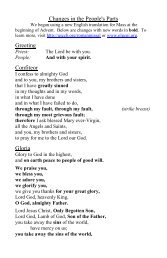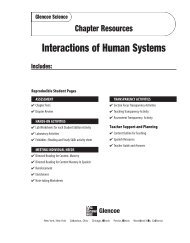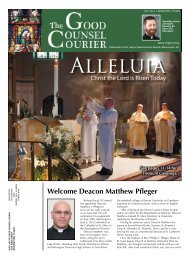Chapter 15 Resource: Support, Movement, and Responses
Chapter 15 Resource: Support, Movement, and Responses
Chapter 15 Resource: Support, Movement, and Responses
- No tags were found...
You also want an ePaper? Increase the reach of your titles
YUMPU automatically turns print PDFs into web optimized ePapers that Google loves.
Glencoe Science<strong>Chapter</strong> <strong>Resource</strong>s<strong>Support</strong>, <strong>Movement</strong>,<strong>and</strong> <strong>Responses</strong>Includes:Reproducible Student PagesASSESSMENT✔ <strong>Chapter</strong> Tests✔ <strong>Chapter</strong> ReviewHANDS-ON ACTIVITIES✔ Lab Worksheets for each Student Edition Activity✔ Laboratory Activities✔ Foldables–Reading <strong>and</strong> Study Skills activity sheetMEETING INDIVIDUAL NEEDS✔ Directed Reading for Content Mastery✔ Directed Reading for Content Mastery in Spanish✔ Reinforcement✔ Enrichment✔ Note-taking WorksheetsTRANSPARENCY ACTIVITIES✔ Section Focus Transparency Activities✔ Teaching Transparency Activity✔ Assessment Transparency ActivityTeacher <strong>Support</strong> <strong>and</strong> Planning✔ Content Outline for Teaching✔ Spanish <strong>Resource</strong>s✔ Teacher Guide <strong>and</strong> Answers
Glencoe SciencePhoto CreditsSection Focus Transparency 1: Jacques M. Chenet/CORBISSection Focus Transparency 2: Owen Franken/CORBIS,Section Focus Transparency 3: Chuck Savage/The Stock Market,Section Focus Transparency 4: Charles Preitner/Visuals UnlimitedCopyright © by The McGraw-Hill Companies, Inc. All rights reserved.Permission is granted to reproduce the material contained herein on the conditionthat such material be reproduced only for classroom use; be provided to students,teachers, <strong>and</strong> families without charge; <strong>and</strong> be used solely in conjunction with the<strong>Support</strong>, <strong>Movement</strong>, <strong>and</strong> <strong>Responses</strong> program. Any other reproduction, for use orsale, is prohibited without prior written permission of the publisher.Send all inquiries to:Glencoe/McGraw-Hill8787 Orion PlaceColumbus, OH 43240-4027ISBN 0-07-867835-8Printed in the United States of America.1 2 3 4 5 6 7 8 9 10 024 09 08 07 06 05 04
ReproducibleStudent PagesReproducible Student Pages■ H<strong>and</strong>s-On ActivitiesMiniLAB: Recognizing Why You Sweat . . . . . . . . . . . . . . . . . . . . . . . . . 3MiniLAB: Try at Home Observing Balance Control. . . . . . . . . . . . . . . 4Lab: Measuring Skin Surface. . . . . . . . . . . . . . . . . . . . . . . . . . . . . . . . . 5Lab: Design Your Own Skin Sensitivity . . . . . . . . . . . . . . . . . . . . . . . . 7Laboratory Activity 1: Muscle Action . . . . . . . . . . . . . . . . . . . . . . . . . . 9Laboratory Activity 2: Analyzing Bones . . . . . . . . . . . . . . . . . . . . . . . 13Foldables: Reading <strong>and</strong> Study Skills. . . . . . . . . . . . . . . . . . . . . . . . . . 17■ Meeting Individual NeedsExtension <strong>and</strong> InterventionDirected Reading for Content Mastery . . . . . . . . . . . . . . . . . . . . . . . 19Directed Reading for Content Mastery in Spanish . . . . . . . . . . . . . . 23Reinforcement . . . . . . . . . . . . . . . . . . . . . . . . . . . . . . . . . . . . . . . . . . 27Enrichment. . . . . . . . . . . . . . . . . . . . . . . . . . . . . . . . . . . . . . . . . . . . . 31Note-taking Worksheet . . . . . . . . . . . . . . . . . . . . . . . . . . . . . . . . . . . 35■ Assessment<strong>Chapter</strong> Review . . . . . . . . . . . . . . . . . . . . . . . . . . . . . . . . . . . . . . . . . 39<strong>Chapter</strong> Test . . . . . . . . . . . . . . . . . . . . . . . . . . . . . . . . . . . . . . . . . . . . 41■ Transparency ActivitiesSection Focus Transparency Activities . . . . . . . . . . . . . . . . . . . . . . . . 46Teaching Transparency Activity . . . . . . . . . . . . . . . . . . . . . . . . . . . . . 51Assessment Transparency Activity . . . . . . . . . . . . . . . . . . . . . . . . . . . 53<strong>Support</strong>, <strong>Movement</strong>, <strong>and</strong> <strong>Responses</strong> 1
H<strong>and</strong>s-On ActivitiesH<strong>and</strong>s-OnActivities2 <strong>Support</strong>, <strong>Movement</strong>, <strong>and</strong> <strong>Responses</strong>
Name Date ClassRecognizing Why You SweatProcedure1. Examine the epidermis <strong>and</strong> the pores of your skin using a magnifying lens.2. Place a clear-plastic s<strong>and</strong>wich bag on your h<strong>and</strong>. Use tape to seal the bagaround your wrist. WARNING: Do not wrap the tape too tightly.3. Quietly study your textbook for 10 min, then look at your h<strong>and</strong>. Remove thebag.4. Describe what happened to your h<strong>and</strong> while it was inside the bag.Analysis1. Identify what formed inside the bag. Where did this substance come from?H<strong>and</strong>s-On Activities2. Why does this substance form even when you are not active?Copyright © Glencoe/McGraw-Hill, a division of the McGraw-Hill Companies, Inc.<strong>Support</strong>, <strong>Movement</strong>, <strong>and</strong> <strong>Responses</strong> 3
Name Date ClassH<strong>and</strong>s-On ActivitiesObserving Balance ControlProcedure1. Place two narrow strips of paper on the wall to form two parallel, verticallines 20–25 cm apart. Have a person st<strong>and</strong> between them for 3 min, withoutleaning on the wall.2. Observe how well balance is maintained.3. Have the person close his or her eyes, then st<strong>and</strong> within the lines for 3 min.Analysis1. When was balance more difficult to maintain? Why?2. What other factors might cause a person to lose his or her sense of balance?Copyright © Glencoe/McGraw-Hill, a division of the McGraw-Hill Companies, Inc.4 <strong>Support</strong>, <strong>Movement</strong>, <strong>and</strong> <strong>Responses</strong>
Name Date ClassMeasuring Skin SurfaceLab PreviewDirections: Answer these questions before you begin the Lab.1. What can you do to prevent injury to clothing or skin in this lab?H<strong>and</strong>s-On Activities2. Once the newspaper suit has been cut <strong>and</strong> removed, how will you find the area?Skin covers the entire surface of your body <strong>and</strong> is your body’s largestorgan. Skin cells make up a layer of skin about 2 mm thick. How big isthis organ?Copyright © Glencoe/McGraw-Hill, a division of the McGraw-Hill Companies, Inc.Real-World QuestionHow much skin covers your body?Goals■ Estimate the surface area of skin that covers the body of a middle-school student.Materials10 large sheets of newspaper tapescissorsmeterstick or rulerSafety PrecautionsProcedure1. Form groups of three or four, either all femaleor all male. Select one person from your groupto measure the surface area of his or her skin.2. Estimate how much skin covers the averagestudent in your classroom. Record your estimationin the Data <strong>and</strong> Observations section.3. Wrap newspaper snugly around each partof your classmate’s body. Overlapping thesheets of paper, use tape to secure the paper.Small body parts, such as fingers <strong>and</strong> toes,do not need to be wrapped individually.Cover entire h<strong>and</strong>s <strong>and</strong> feet. Do not coverthe face.4. After your classmate is completely coveredwith paper, carefully cut the newspaper offhis or her body. WARNING: Do not cut anyclothing or skin.5. Lay all of the overlapping sheets of newspaperon the floor. Using scissors <strong>and</strong>more tape, cut <strong>and</strong> piece the paper suittogether to form a rectangle.6. Using a meterstick, measure the length <strong>and</strong>width of the resulting rectangle. Multiplythese two measurements for an estimate ofthe surface area of your classmate’s skin.<strong>Support</strong>, <strong>Movement</strong>, <strong>and</strong> <strong>Responses</strong> 5
Name Date Class(continued)H<strong>and</strong>s-On ActivitiesData <strong>and</strong> ObservationsSurface Area Estimate: Skin <strong>and</strong> Newspaper SuitSkin Surface Newspaper Newspaper NewspaperEstimate Length Width AreaConclude <strong>and</strong> Apply1. Was your estimation correct? Explain.2. How accurate are your measurements of your classmate’s skin surface area? How could yourmeasurements be improved?3. Calculate the volume of your classmate’s skin, using 2 mm as the average thickness <strong>and</strong> yourcalculated surface area from this lab.Communicating Your DataUsing a table, record the estimated skin surface area from all groups in your class. Findthe average surface areas for both males <strong>and</strong> females. Discuss any differences in these twoaverages.Copyright © Glencoe/McGraw-Hill, a division of the McGraw-Hill Companies, Inc.6 <strong>Support</strong>, <strong>Movement</strong>, <strong>and</strong> <strong>Responses</strong>
Name Date ClassDesign Your OwnSkin SensitivityLab PreviewDirections: Answer these questions before you begin the Lab.1. What safety symbols are associated with this lab?H<strong>and</strong>s-On Activities2. What are the receptors called that allow you to sense touch located in the skin?Your body responds to touch, pressure, temperature, <strong>and</strong> other stimuli. Notall parts of your body are equally sensitive to stimuli. Some areas are moresensitive than others. For example, your lips are sensitive to heat. This protectsyou from burning your mouth <strong>and</strong> tongue. Now think about touch.How sensitive to touch is the skin on various parts of your body?Copyright © Glencoe/McGraw-Hill, a division of the McGraw-Hill Companies, Inc.Real-World QuestionWhch areas can distinguish the smallestamount of distance between stimuli?Form a HypothesisBased on your experiences, state a hypothesisabout which of the following five areas of thebody—fingertip, forearm, back of the neck,palm, <strong>and</strong> back of the h<strong>and</strong>—you believe tobe most sensitive. Rank the areas from 5 (themost sensitive) to 1 (the least sensitive).Goals■ Observe the sensitivity to touch on specificareas of the body.■ Design an experiment that tests the effects of avariable, such as how close the contact pointsare, to determine which body areas can distinguishwhich stimuli are closest to one another.Possible Materials3-in ✕ 5-inindex cardtoothpickstape*gluemetric ruler*Alternate materialsSafety PrecautionsWARNING: Do not apply heavy pressure whentouching the toothpicks to the skin of yourclassmates.Test Your HypothesisMake a Plan1. As a group, agree upon <strong>and</strong> write thehypothesis statement.2. As a group, list the steps you need to test yourhypothesis. Describe exactly what you will doat each step. Consider the following as youlist the steps. How will you know that sight isnot a factor? How will you use the cardshown below to determine sensitivity totouch? How will you determine that one orboth points are sensed?3. Design a data table in your Science Journalto record your observations.4. Reread your entire experiment to makesure that all steps are in the correct order.5. Identify constants, variables, <strong>and</strong>controls of the experiment.10 mm5 mm1 mm3 mm<strong>Support</strong>, <strong>Movement</strong>, <strong>and</strong> <strong>Responses</strong> 7
Name Date ClassCopyright © Glencoe/McGraw-Hill, a division of the McGraw-Hill Companies, Inc.1LaboratoryActivityMuscle ActionMuscles attached to your eyelid allow you to blink your eyes. Is it necessary to remind yourselfto blink or does the muscle do its job automatically? Can you stop yourself from blinking if youthink about it? Muscles that do not have to be reminded are called involuntary. Those musclesthat you control are called voluntary muscles. Do the eyelid muscles ever behave as both voluntary<strong>and</strong> involuntary muscles? Do some experimenting to see if you can answer this <strong>and</strong> a few otherquestions about blinking.StrategyYou will perform three different experiments to discover if blinking is voluntary,involuntary, or both.You will record your observations during these experiments so that you can makeconclusions about blinking.You will determine if blinking has any protective or useful purpose.Materialsclock or watch with second h<strong>and</strong>clear plastic sheet 30 ✕ 30 cmlarge cotton ball (about the size of a tennis ball)ProcedurePart A1. Look at your partner’s eyes. Count thenumber of blinks in 1 min. NOTE: Do nottry to reduce the number of normal blinks.2. Record the number in Table 1 in Data <strong>and</strong>Observations.3. Repeat steps 1 <strong>and</strong> 2 three more times.4. Complete the table by determining thetotal <strong>and</strong> average number of blinks.5. Repeat steps 1–4 with your partner lookingat your eyes.Part B1. Watch your partner’s eyes again. Time inseconds how long he/she can go withoutblinking. Record the number in Table 2 inData <strong>and</strong> Observations.2. Change roles again. Have your partnertime in seconds how long you can go withoutblinking. Notice <strong>and</strong> remember thefeeling of your eyes during this time.Part C1. Have your partner hold a sheet of clearplastic in front of his/her face.NOTE: The plastic sheet should not touchyour partner’s face. As you throw a piece ofcotton about the size of a tennis ball at theplastic, notice <strong>and</strong> record if your partnerdoes or does not blink. Use a check markto record this information in Table 3.2. Repeat step 1 of Part C five more times <strong>and</strong>record the results each time.H<strong>and</strong>s-On Activities<strong>Support</strong>, <strong>Movement</strong>, <strong>and</strong> <strong>Responses</strong> 9
Name Date ClassLaboratory Activity 1 (continued)H<strong>and</strong>s-On ActivitiesData <strong>and</strong> ObservationsTable 1Number of Blinks in 1 MinuteTrial Classmate Yourself1234TotalAverageTable 2Time Without Blinking (s)YouYour partnerTable 3Trial Did Blink Did Not Blink123456Copyright © Glencoe/McGraw-Hill, a division of the McGraw-Hill Companies, Inc.10 <strong>Support</strong>, <strong>Movement</strong>, <strong>and</strong> <strong>Responses</strong>
Name Date ClassLaboratory Activity 1 (continued)Questions <strong>and</strong> Conclusions1. Does Part A show that blinking is voluntary or involuntary? Explain.2. Does Part A show that blinking is protective? Explain.H<strong>and</strong>s-On Activities3. Does Part B (no blinking) show voluntary or involuntary muscle action? Explain.4. It is important for people’s eyes to remain moist. Describe how your eyes felt after notblinking. Do you think that blinking is helpful <strong>and</strong> protective? Explain.Copyright © Glencoe/McGraw-Hill, a division of the McGraw-Hill Companies, Inc.5. How might you explain the fact that your average time <strong>and</strong> that of your partner in Part B arenot the same?6. What does the activity with the cotton ball <strong>and</strong> plastic help prove? Explain.<strong>Support</strong>, <strong>Movement</strong>, <strong>and</strong> <strong>Responses</strong> 11
Name Date ClassCopyright © Glencoe/McGraw-Hill, a division of the McGraw-Hill Companies, Inc.2LaboratoryActivityAnalyzing BonesThe skeletal system provides support for the body <strong>and</strong> protection for internal organs. In orderto provide these functions, bones must be hard <strong>and</strong> strong. Scientists have discovered that theelement calcium is responsible for making bones strong. Adding calcium to a bone can make itstronger, while removing calcium will make the bone weak <strong>and</strong> brittle. The amount of calcium inbones can change over time. Certain types of hard physical exercise <strong>and</strong> work can result in a gainof calcium to bones, while certain diseases <strong>and</strong> diets can result in a loss of calcium from bones.StrategyYou will test the hardness of chicken bones before <strong>and</strong> after soaking them in different liquids.You will hypothesize which solutions will remove calcium from bones <strong>and</strong> test your hypothesis.Materialshydrogen peroxidewatervinegara liquid chosen by the student4 beakers or jarschicken leg bones (boiled <strong>and</strong> cleaned)forcepsWARNING: Wear gloves throughout this experiment. Do not taste, eat, or drink any materials usedin the lab. Inform your teacher if you come into contact with any chemicals.Procedure1. Four liquids will be tested for their effectson bones. Three of these liquids are listedin Table 1. You should choose a fourthliquid to test (lemon juice, fruit juices, softdrinks, milk, <strong>and</strong> so forth). Have yourchoice approved by your teacher <strong>and</strong> thenrecord the type of liquid in Table 1 in Data<strong>and</strong> Observations.2. Make a hypothesis about the effects eachliquid will have on the strength of chickenbones. Write your hypotheses in Table 1.3. Check the hardness of a chicken bone bygently twisting <strong>and</strong> bending the bone. Becareful not to crack or break the bone.Write your observations on the lines providedin the Data <strong>and</strong> Observations section.4. Fill each beaker with one of the liquids.Label the beakers with your name <strong>and</strong> thekind of liquid.5. Place a bone in each beaker of liquid. After10 min, observe the bones <strong>and</strong> record inTable 2 any changes that you see.6. After 48–72 h, use forceps to remove thebones from the liquids. Rinse the boneswith water <strong>and</strong> observe them carefully.Record your observations in Table 2.7. Retest the bones for hardness by twisting<strong>and</strong> bending. Record the results of the testin the Results column of Table 1.H<strong>and</strong>s-On Activities<strong>Support</strong>, <strong>Movement</strong>, <strong>and</strong> <strong>Responses</strong> 13
Name Date ClassLaboratory Activity 2 (continued)H<strong>and</strong>s-On ActivitiesData <strong>and</strong> ObservationsTable 1LiquidWaterVinegarHypothesisResultsHydrogen peroxideOriginal Observations of bone hardness:Table 2Liquid Observations (after 10 min) Observations (after 48–72 h)WaterVinegarHydrogenperoxideTable 2Questions <strong>and</strong> Conclusions1. What liquids removed calcium from bone?Copyright © Glencoe/McGraw-Hill, a division of the McGraw-Hill Companies, Inc.14 <strong>Support</strong>, <strong>Movement</strong>, <strong>and</strong> <strong>Responses</strong>
Name Date ClassLaboratory Activity 2 (continued)2. How accurate were your hypotheses for the effects of each liquid?3. A baby’s bones are softer than a teenager’s. What might be a reason for this?H<strong>and</strong>s-On Activities4. Some older persons suffer from a disease called osteoporosis, which results from calcium lossin bones. The bones weaken <strong>and</strong> are more likely to break. One way to help prevent osteoporosisis to eat calcium-rich foods. What foods could you eat to obtain more calcium?Copyright © Glencoe/McGraw-Hill, a division of the McGraw-Hill Companies, Inc.5. Scientists have discovered that astronauts lose bone calcium while they are exposed to themicrogravity of space. What might be a reason for this <strong>and</strong> what could astronauts do toprevent or slow the loss of calcium?Strategy CheckCan you test the hardness of chicken bones before <strong>and</strong> after soaking them in differentliquids?Can you hypothesize which solutions will remove calcium from bones <strong>and</strong> testyour hypothesis?<strong>Support</strong>, <strong>Movement</strong>, <strong>and</strong> <strong>Responses</strong> <strong>15</strong>
Name Date ClassDirections: Use this page to label your Foldable at the beginning of the chapter.<strong>Support</strong>, <strong>Movement</strong>, <strong>and</strong><strong>Responses</strong>SkinMuscle<strong>Support</strong>, <strong>Movement</strong>, <strong>and</strong><strong>Responses</strong>BoneNerveH<strong>and</strong>s-On Activitiescan be skeletal, smooth or cardiaccontracts to move bones <strong>and</strong> body partsCopyright © Glencoe/McGraw-Hill, a division of the McGraw-Hill Companies, Inc.has nerve cells that detect <strong>and</strong> relay informationhelps muscles movesends impulses to the brain <strong>and</strong> spinal cordprotects internal organsprotects the body, prevents water loss, <strong>and</strong> maintains body temperaturehas sense organs that are adapted for intercepting stimulisupports the body <strong>and</strong> gives it shape<strong>Support</strong>, <strong>Movement</strong>, <strong>and</strong> <strong>Responses</strong> 17
Meeting Individual NeedsMeeting IndividualNeeds18 <strong>Support</strong>, <strong>Movement</strong>, <strong>and</strong> <strong>Responses</strong>
Name Date ClassDirected Reading forContent MasteryOverview<strong>Support</strong>, <strong>Movement</strong>, <strong>and</strong> <strong>Responses</strong>Directions: Use the words below to fill in the blanks beneath the illustrations of joints.gliding neck kneepivot hinge vertebrae1. type: ______________ 3. type: ______________ 5. type: __________________________________ ____________________ ____________________2. example: ___________ 4. example: ___________ 6. example: _______________________________ ____________________ ____________________Meeting Individual NeedsCopyright © Glencoe/McGraw-Hill, a division of the McGraw-Hill Companies, Inc.Directions: Complete the following sentences using the terms listed below.skin skeletal protection tendonsdendrites axons synapse7. Muscles that move bones are called ____________________ muscles.These kinds of muscles are attached to bones by thick b<strong>and</strong>s of tissuecalled ____________________.8. Your ____________________ is the largest organ in your body. Its mostimportant function is ____________________.9. Nerve cell branches called _____________ send impulses to the cell body.Branches called __________________ send impulses away from the cell body.10. Impulses move from neuron to neuron across a ____________________.<strong>Support</strong>, <strong>Movement</strong>, <strong>and</strong> <strong>Responses</strong> 19
Nombre Fecha ClaseLectura dirigida paraDominio del contenidoSección 1 ■ La pielSección 4 ■ El sistema nerviosoSatisface las necesidades individualesInstrucciones: Escribe la letra la letra del término o frase que mejor complete cada oración.1. La piel consiste en ______ capas de tejidos.a. dos b. tres2. La capa exterior y más fina de la piel es la ______a. dermis b. epidermis3. El pigmento que proteje tu piel y le da color es la ______.a. melanina b. vitamina D4. Una de las funciones de la piel es la de regular ______.a. temperatura corporal b. músculos5. La piel es el ______ mas gr<strong>and</strong>e del cuerpo.a. tejido b. órgano6. Las células exteriores de la epidermis están ______.a. vivas b. muertasInstrucciones: Completa el párrafo us<strong>and</strong>o los términos de la siguiente lista.equilibrio olfativas papilas gustativas saladorayos luminosos amargo moléculasnervio óptico estímulos sonorasLos sentidos actúan como el sistema de alerta del cuerpo, reaccion<strong>and</strong>o a7. ________________ y transmitiendo impulsos al encéfalo. Los ojos detectan ytransmiten 8. ________________ al encéfalo por medio de 9. ________________.Además de detectar y transmitir ondas 10. ____________ ___________, el oídotambién controla el 11. ________________ del cuerpo reaccion<strong>and</strong>o almovimiento. Las células 12. ________________ en las vías nasales detectan13. ________________ en el aire y transmiten estos impulsos como olores. Las14. ________________ de la lengua pueden detectar cinco estímulos diferentes,dulce, ácido, <strong>15</strong>. ________________, 16. ________________ y el sabor del MSG.Copyright © Glencoe/McGraw-Hill, a division of the McGraw-Hill Companies, Inc.24 Apoyo, movimiento, y respuesta
Nombre Fecha ClaseLectura dirigida paraDominio del contenidoSección 2 ■Sección 3 ■El sistema muscularEl sistema óseoInstrucciones : Utiliza las siguientes pistas para completar el crucigrama.cardíaco fija articulación ligamento médulaliso osteoblasto periósteo óseo cartílago125683 47Satisface las necesidades individualesCopyright © Glencoe/McGraw-Hill, a division of the McGraw-Hill Companies, Inc.9Horizontales2. tipo de articulación con poco oningún movimiento3. sustancia en el centro de la cavidadde los huesos largos5. músculo que mueve los huesos6. lugar donde se juntan dos o máshuesos8. b<strong>and</strong>a de tejidos fuertes que unelos huesos en las articulaciones9. capa de tejido liso, resbaloso ygrueso que cubre los extremos de loshuesosVerticales1. tipo de músculo que se encuentrasólo en el corazón4. membrana apretada que cubre lasuperficie del hueso.5. célula formadora de hueso7. tipo de músculo que se encuentrasolo en los intestinos, vejiga, venasy otros órganos internosApoyo, movimiento, y respuesta 25
Nombre Fecha ClaseLectura dirigida paraDominio del contenidoTérminos clavesApoyo, movimiento, y respuestasSatisface las necesidades individualesInstrucciones: Decifra los terminos en itálicas para completar las oraciones a continuación. Escribe el término en lalínea en blanco.1. Los huesos se juntan en las acioticularnes.2. Los cargostila es una capa lisa de tejido en la punta delos huesos que absore el impacto.3. Los mentosliga mantienen unidos a los huesos en lasarticulaciones.4. Una aunrnoe es la unidad básica del sistema nervioso.5. Los dontenes mantienen los músculos unidos a loshuesos.6. El sistema nervioso ltrnaec consiste del cerebro y lamédula espinal.7. El espacio a través del cual viajan los impulsos sellama pnssiasi.8. La dmisr es la capa de la piel que se encuentra debajode la epidermis.9. La capa exterior de la piel se llama misederpi.10. La ninmeala ges un pigmento que da color a la piel.11. El sistema nervioso coripeféri conecta el cerebro y lamédula espinal con otras partes del cuerpo.12. Los múculos que puedes controlar se llaman músculosluvoriontas.13. Los músculos tavoinlunrios son músculos que nopuedes controlar concientemente.14. La superficie de un hueso vivo está cubierto por unamembrana fuerte y apretada llamada teriópeso.Copyright © Glencoe/McGraw-Hill, a division of the McGraw-Hill Companies, Inc.26 Apoyo, movimiento, y respuesta
Name Date Class2ReinforcementThe Muscular SystemMeeting Individual NeedsDirections: Think of the type of muscle associated with each of the following body parts. In the space provided,write the name of the type of muscle associated with that body part. Also tell whether that muscle is voluntaryor involuntary.1. thigh:2. upper arm:3. intestine:4. heart:5. calf:6. stomach:7. h<strong>and</strong>:8. blood vessels:9. uterus:10. neck:Directions: The two illustrations show an ankle bending. Label the second illustration, showing which musclecontracts <strong>and</strong> which muscle relaxes.ContractsRelaxes11a.12. About how many muscles are in the body?13. How do muscles produce mechanical energy?11b.Copyright © Glencoe/McGraw-Hill, a division of the McGraw-Hill Companies, Inc.14. What happens when the supply of energy-rich molecules in a muscle is used up?28 <strong>Support</strong>, <strong>Movement</strong>, <strong>and</strong> <strong>Responses</strong>
Name Date Class3ReinforcementThe Skeletal SystemDirections: Study the illustrations. Then label each one using the correct term from the list.pivot joint ball-<strong>and</strong>-socket joint hinge joint gliding joint1. 2.Meeting Individual NeedsCopyright © Glencoe/McGraw-Hill, a division of the McGraw-Hill Companies, Inc.3. 4.Directions: Describe each type of joint.5. pivot joint:6. ball-<strong>and</strong>-socket joint:7. hinge joint:8. gliding joint:Directions: List the five major functions of the skeletal system.9.10.11.12.13.<strong>Support</strong>, <strong>Movement</strong>, <strong>and</strong> <strong>Responses</strong> 29
Name Date Class4ReinforcementThe Nervous SystemDirections: Define each term. Use the terms to label the diagram below.1. neuron2. dendrite3. axon4. synapseMeeting Individual Needs6.7.5.8.9.Directions: Name the three kinds of neurons <strong>and</strong> describe the function of each.10.11.12.Directions: Answer the following questions on the lines provided.13. What are the three main sections of the ear?14. In what cells does a smell impulse begin?<strong>15</strong>. What five basic taste sensations do the taste buds have?Copyright © Glencoe/McGraw-Hill, a division of the McGraw-Hill Companies, Inc.30 <strong>Support</strong>, <strong>Movement</strong>, <strong>and</strong> <strong>Responses</strong>
Name Date Class1EnrichmentInvestigating SunscreensMany people think tanned skin looks healthy. Some people lie in the sun for hours in order tohave the tanned skin they think improves their appearance.During winter, some even go totanning salons to keep up their summer tan. In the past, people didn’t generally use products toprotect their skin from the sun.But doctors are now warning us about the danger of too muchsun. Find out how too much sun is dangerous using these sources: the library,the labels on bottlesof sunscreen, <strong>and</strong> the pharmacist at your local drugstore. First, answer as many questions as youcan using library references. You might begin by looking for books <strong>and</strong> articles about cancer,skincancer,or effects of sunlight on skin. Next, look at the labels on bottles of sunscreen you have athome or at your local drugstore. Then ask the pharmacist at the drugstore any questions you haveabout sunscreens.Meeting Individual NeedsCopyright © Glencoe/McGraw-Hill, a division of the McGraw-Hill Companies, Inc.1. What kind of cancer can you get from too much sun?2. How does sunlight affect the aging of the skin?3. What does the SPF number of sunscreen lotions mean?4. What SPF number do doctors or pharmacists recommend you use when exposing yourself tothe sun?5. While in the sun, how often should you apply sunscreen?<strong>Support</strong>, <strong>Movement</strong>, <strong>and</strong> <strong>Responses</strong> 31
Name Date Class2Enrichment The Muscular SystemMeeting Individual NeedsMaterialschicken leg <strong>and</strong> thigh, cooked thoroughlysharp kitchen knifeProcedure1. Boil the chicken leg <strong>and</strong> thigh until they arecompletely cooked. WARNING: Alwayswash h<strong>and</strong>s <strong>and</strong> surfaces thoroughly aftercontact with meats.2. Use the knife to cut the skin away. Try not tocut any of the meat. WARNING: Always useextreme care when using sharp instruments.3. Closely examine the bundles of muscleunder the skin. Then examine the ends ofthe muscles at the knee joint.4. Carefully cut away all the flesh fromaround the knee joint. Try to count howmany different bundles there are in thechicken leg.Data <strong>and</strong> Observations1. The word striated means “made up of elongated fibers.” Are the muscles of a chicken’s legKnee jointstriated or smooth?2. How are the muscles of the chicken leg attached to the bone?3. As you cut the muscles away from the joint, how many bundles did you count?Conclude <strong>and</strong> Apply1. The chicken leg is the same as what part of our leg?2. What part of the chicken do we call meat?Copyright © Glencoe/McGraw-Hill, a division of the McGraw-Hill Companies, Inc.32 <strong>Support</strong>, <strong>Movement</strong>, <strong>and</strong> <strong>Responses</strong>
Name Date ClassNote-takingWorksheet<strong>Support</strong>, <strong>Movement</strong>, <strong>and</strong> <strong>Responses</strong>Section 1 The SkinA. Your skin is the ___________ organ of your body.B. Skin is made up of _________ layers of tissueUnderlined words <strong>and</strong>phrases are to be filledin by students on theNote-taking Worksheet.1. _____________—the outer, thinnest layera. New cells are constantly produced at the ________ of the epidermis.b. Cells produce melanin, a pigment that ____________ your skin <strong>and</strong> gives it color.2. __________—the middle layera. The dermis is ___________ than the epidermis.b. The dermis contains blood vessels, __________, muscles, oil, sweat gl<strong>and</strong>s, <strong>and</strong> other structures.3. Fatty layer—_________ the bodyC. Skin has many functions.1. Protection—forms a protective covering over the body that prevents __________2. Sensory response—_____ cells in the skin detect <strong>and</strong> relay information to the brainMeeting Individual Needs3. Formation of _____________, which helps your body absorb calcium4. Regulation of body _______________Copyright © Glencoe/McGraw-Hill, a division of the McGraw-Hill Companies, Inc.5. Elimination of __________ through sweat gl<strong>and</strong>sD. When injured, the skin produces new cells <strong>and</strong> repairs tears; ___________ happen when tinyblood vessels beneath the skin burst <strong>and</strong> leak into surrounding tissues.Section 2 The Muscular SystemA. A muscle is an organ that can relax <strong>and</strong> contract, providing the _________ to move your body.1. _____________ muscles—muscles that you are able to control2. _______________ muscles—muscles that you cannot controlB. There are three types of muscle tissue.1. Skeletal muscles move _________ .a. Tendons are thick b<strong>and</strong>s of tissue that __________ muscle to bones.b. _____________ muscles2. Smooth muscles—found in ___________________, are _______________ muscles.3. Cardiac muscle—found only in the _________<strong>Support</strong>, <strong>Movement</strong>, <strong>and</strong> <strong>Responses</strong> 35
Name Date ClassNote-taking Worksheet (continued)C. You move because pairs of ___________ work together; when one muscle of a pair contracts,the other ___________.Section 3 The Skeletal SystemA. All the _________ in your body make up your skeletal system, which has five major functions.1. Your skeleton gives shape <strong>and</strong> ___________ to your body.2. Your bones protect your ___________________.Meeting Individual Needs3. Major ___________ are attached to your bones.4. _______________ are formed in the red marrow in the center of your bones.5. ___________ <strong>and</strong> phosphorus compounds are stored in your skeleton for later use.B. Bone structure1. ______________—a tough, tight-fitting membrane that covers the bone’s surface2. ___________ bone—the hard, strong layer under the periosteum3. __________ bone—found toward the ends of long bones4. Cartilage—a rubbery layer of tissue found at the ends of bones, where they form __________C. Before birth, your skeleton begins as _____________, which is gradually replaced by bone.D. Joints—any place where two or more bones come _____________; bones are held in place bya tough b<strong>and</strong> of tissue called a _____________.E. Types of joints1. _____________ joint—allows little or _____________ movement2. _________ joint—one bone ___________ in a ring of a stationary bone3. ___________ joint—the ___________ end of one bone fits into a cuplike cavity onanother bone4. _________ joint—back-<strong>and</strong>-forth ___________5. ___________ joint—one part of a bone slides over another bone; used the __________in the bodyCopyright © Glencoe/McGraw-Hill, a division of the McGraw-Hill Companies, Inc.36 <strong>Support</strong>, <strong>Movement</strong>, <strong>and</strong> <strong>Responses</strong>
Name Date ClassNote-taking Worksheet (continued)Section 4The Nervous SystemA. Your nervous system helps your body make adjustments to changes in your _______________.1. Stimulus—any change inside or outside your body that brings about a(n) ____________2. _______________—the regulation of steady conditions inside an organismB. Neurons are made up of a cell body <strong>and</strong> ____________ called dendrites <strong>and</strong> axons.1. _____________ receive messages <strong>and</strong> send them to the cell body.2. _________ carry messages away from the cell body.C. The central nervous system is made up of the brain <strong>and</strong> _______________.D. The peripheral nervous system connects your brain <strong>and</strong> spinal cord to __________________.1. The somatic system controls _____________ actions.2. The autonomic system controls _______________ actions.E. Reflex—an involuntary, automatic response to a stimulus controlled by the ________________Meeting Individual NeedsF. Your body has ________ senses:1. VisionCopyright © Glencoe/McGraw-Hill, a division of the McGraw-Hill Companies, Inc.a. Light enters your eye <strong>and</strong> stimulates the ________ <strong>and</strong> _________, the found in yourretina.b. These send impulses to the _______________.c. The visual area of your brain ______________ the image <strong>and</strong> you “see.”2. Hearing—when an object vibrates, it produces _______________ necessary for hearing sound.3. Smella. Food <strong>and</strong> other objects give off _____________ that stimulate nerve cells, called___________________.b. The olfactory cells send impulses to the _________, where the stimulus is interpreted.4. Taste—______________ on your tongue are the major sensory receptors.5. Touch—sensory receptors pick up changes in touch, pressure, pain, <strong>and</strong> temperature <strong>and</strong>send impulses to the _________ or _______________.<strong>Support</strong>, <strong>Movement</strong>, <strong>and</strong> <strong>Responses</strong> 37
AssessmentAssessment38 <strong>Support</strong>, <strong>Movement</strong>, <strong>and</strong> <strong>Responses</strong>
Name Date Class<strong>Chapter</strong>Review<strong>Support</strong>, <strong>Movement</strong>, <strong>and</strong> <strong>Responses</strong>Part A. Vocabulary ReviewDirections: Select the term from the following list that matches each description.cartilage dermis epidermisvoluntary muscles involuntary muscles jointligaments melanin tendons periosteum1. any muscles that you consciously control2. thick, smooth layer of tissue that covers the ends of bones3. any place where two bones meet.4. tough b<strong>and</strong>s of tissue that hold bones together5. any muscles that you do not consciously control6. thick b<strong>and</strong>s of tissue that attach muscles to bones7. the outermost layer of the skin8. the middle layer of tissue under the epidermis9. chemical that gives skin its color10. tough, tight-fitting membrane covering surface of boneCopyright © Glencoe/McGraw-Hill, a division of the McGraw-Hill Companies, Inc.Directions: Write the name of each bone part shown in the illustration below.11.12.13.Directions: Complete the following sentences using the correct terms.14. The space between one neuron <strong>and</strong> the next is a ____________________.<strong>15</strong>. The system made up of the brain <strong>and</strong> spinal cord is the ____________________.16. The ____________________ connects the brain <strong>and</strong> spinal cord to other body parts.17. The basic unit of the nervous system is the ____________________.Assessment<strong>Support</strong>, <strong>Movement</strong>, <strong>and</strong> <strong>Responses</strong> 39
Name Date Class<strong>Chapter</strong> Review (continued)AssessmentPart B. Concept Review1. List the five major functions of the skeletal system.a.b.c.d.e.2. List five functions of skin.a.b.c.d.e.3. List three types of movable joints <strong>and</strong> give an example of each.a.b.c.4. Number the following steps in the order in which they happen when light enters the eye.______ a. Light passes through the lens.______ b. Impulses from rods <strong>and</strong> cones in the retina pass to the optic nerve.______ c. The optic nerve carries the impulses to the visual area of the cortex______ d. Light passes through the cornea.______ e. The lens directs rays onto the retina.5. How does a depressant affect your nervous system?6. How does a stimulant affect your nervous system?Copyright © Glencoe/McGraw-Hill, a division of the McGraw-Hill Companies, Inc.40 <strong>Support</strong>, <strong>Movement</strong>, <strong>and</strong> <strong>Responses</strong>
TransparencyActivitiesTransparency Activities<strong>Support</strong>, <strong>Movement</strong>, <strong>and</strong> <strong>Responses</strong> 45
1Section FocusTransparency ActivityA Matter of PerceptionYou might be able to identify a sculpture of a goose by looking at it,but how might you identify it if you couldn’t see it? This man is usinghis sense of touch to identify <strong>and</strong> investigate the sculpture.Transparency Activities1. What are some functions of the skin?2. What role is skin playing in studying the sculpture?3. How does a blind person read?Copyright © Glencoe/McGraw-Hill, a division of the McGraw-Hill Companies, Inc.46 <strong>Support</strong>, <strong>Movement</strong>, <strong>and</strong> <strong>Responses</strong>
Name Date Class2Section Focus No SweatTransparency ActivityJust after World War II, an English neurosurgeon named SirLudwig Guttman organized a competition for people in wheelchairs.Today, opportunities exist for everyone to participate in a variety ofsports <strong>and</strong> recreation at all levels.Copyright © Glencoe/McGraw-Hill, a division of the McGraw-Hill Companies, Inc.1. Name a body system that helps people to move.2. What do hitting a tennis ball <strong>and</strong> a heartbeat have in common?How are they different?Transparency Activities<strong>Support</strong>, <strong>Movement</strong>, <strong>and</strong> <strong>Responses</strong> 47
Name Name Date Date Class Class3Cloud CatchersSection FocusTransparency ActivityIf you’ve ever watched a skyscraper being built, you may havenoticed the first part to go up is the metal frame that supports thebuilding. After the skyscraper is completed, the frame usually cannotbe seen.Transparency Activities1. What is the function of the frame in the picture?2. How is the function of this metal frame similar to your “frame”?Copyright © Glencoe/McGraw-Hill, a division of the McGraw-Hill Companies, Inc.48 <strong>Support</strong>, <strong>Movement</strong>, <strong>and</strong> <strong>Responses</strong>
Name Date Class4Section Focus Life in the BalanceTransparency ActivityOne of the attractions of a circus is the skilled performers. Walkingon a tightrope requires a keen sense of balance <strong>and</strong> years of practice<strong>and</strong> training. Can you see this performer’s feet on the wire?Copyright © Glencoe/McGraw-Hill, a division of the McGraw-Hill Companies, Inc.1. What sort of shoes is the performer wearing? Why?2. What senses do you think help us maintain balance?Transparency Activities<strong>Support</strong>, <strong>Movement</strong>, <strong>and</strong> <strong>Responses</strong> 49
Name Date Class3Teaching TransparencyActivityHuman BonesCopyright © Glencoe/McGraw-Hill, a division of the McGraw-Hill Companies, Inc.Transparency Activities<strong>Support</strong>, <strong>Movement</strong>, <strong>and</strong> <strong>Responses</strong> 51
Name Date ClassTeaching Transparency Activity (continued)1. What is the function of the periosteum?2. What is the name of the bone in your upper arm?3. What are two kinds of bone marrow? What does each do?4. What is the name given to the compact bone circular structure?5. What are the five functions of the skeletal system?Transparency ActivitiesCopyright © Glencoe/McGraw-Hill, a division of the McGraw-Hill Companies, Inc.52 <strong>Support</strong>, <strong>Movement</strong>, <strong>and</strong> <strong>Responses</strong>
Name Date ClassAssessmentTransparency Activity<strong>Support</strong>, <strong>Movement</strong>,<strong>and</strong> <strong>Responses</strong>Directions: Carefully review the table <strong>and</strong> answer the following questions.Reaction Experiment ResultsStudentsDorotheaBillyHansS<strong>and</strong>raMarthaLeoDistance of Catch (cm)510<strong>15</strong>202530Reaction Time (s)0.100.130.16?0.220.25Copyright © Glencoe/McGraw-Hill, a division of the McGraw-Hill Companies, Inc.1. According to the information in the table, the student with thelowest reaction time is ___.A LeoC HansB BillyD Dorothea2. Based on the relationship between catch distance <strong>and</strong> reactiontime, which is most likely S<strong>and</strong>ra’s reaction time?F 0.10 sH 0.19 sG 0.18 sJ 0.21 s3. Eleanor, another student, is asked to participate in the experiment.Her reaction time was determined to be 0.23 seconds. Based on theinformation in the table, Eleanor’s catch distance would be ___.A 31.<strong>15</strong> cmC 24.25 cmB 26.67 cmD 21.67 cmTransparency Activities<strong>Support</strong>, <strong>Movement</strong>, <strong>and</strong> <strong>Responses</strong> 53


